Guozhong Cao. Nanostructures & Nanomaterials: Synthesis, Properties & Applications
Подождите немного. Документ загружается.


336
Nanostructures and Nanomaterials
fields fiom biological structures to porosity in coals to dispersoids in struc-
tural engineering materials. It should also be noted that the theory of visible
light scattering2* is almost identical to that of SAXS described above if the
following condition is met:
81~R(n1- n2)
n2X
<<
1
where
nl
and
n2
are the refractive indices of a particle and its environment,
respectively. However, visible light scattering is limited to systems only
when
R
is larger than approximately
80
nm.
8.2.3.
Scanning electron microscopy
(SEM)
SEM
is one of the most widely used techniques used in characterization
of nanomaterials and nanostructures. The resolution of the
SEM
approaches a few nanometers, and the instruments can operate at magni-
fications that are easily adjusted from
-
10
to over
300,000.
Not only does
the
SEM
produce topographical information as optical microscopes do, it
also provides the chemical composition information near the surface.
In a typical
SEM,
a source of electrons is focused into a beam, with a
very fine spot size of
-5
nm and having energy ranging from a few hun-
dred eV to 50Key that is rastered over the surface of the specimen by
deflection coils. As the electrons strike and penetrate the surface, a num-
ber of interactions occur that result in the emission of electrons and pho-
tons from the sample, and
SEM
images are produced by collecting the
emitted electrons on a cathode ray tube (CRT). Various
SEM
techniques
are differentiated on the basis of what is subsequently detected and
imaged, and the principle images produced in the
SEM
are of three types:
secondary electron images, backscattered electron images and elemental
X-ray maps. When a high-energy primary electron interacts with an atom,
it undergoes either inelastic scattering with atomic electrons or elastic
scattering with the atomic nucleus. In an inelastic collision with an elec-
tron,
the primary electron transfers part of its energy to the other electron.
When the energy transferred is large enough, the other electron will emit
from the sample. If the emitted electron has energy
of
less than
50
eV,
it
is
referred to as a secondary electron. Backscattered electrons are the high-
energy electrons that are elastically scattered and essentially possess the
same energy as the incident or primary electrons. The probability of
backscattering increases with the atomic number of the sample material.
Although backscattering images cannot be used for elemental identifica-
tion, useful contrast can develop between regions of the specimen that dif-
fer widely in atomic number,
Z.
An additional electron interaction in the
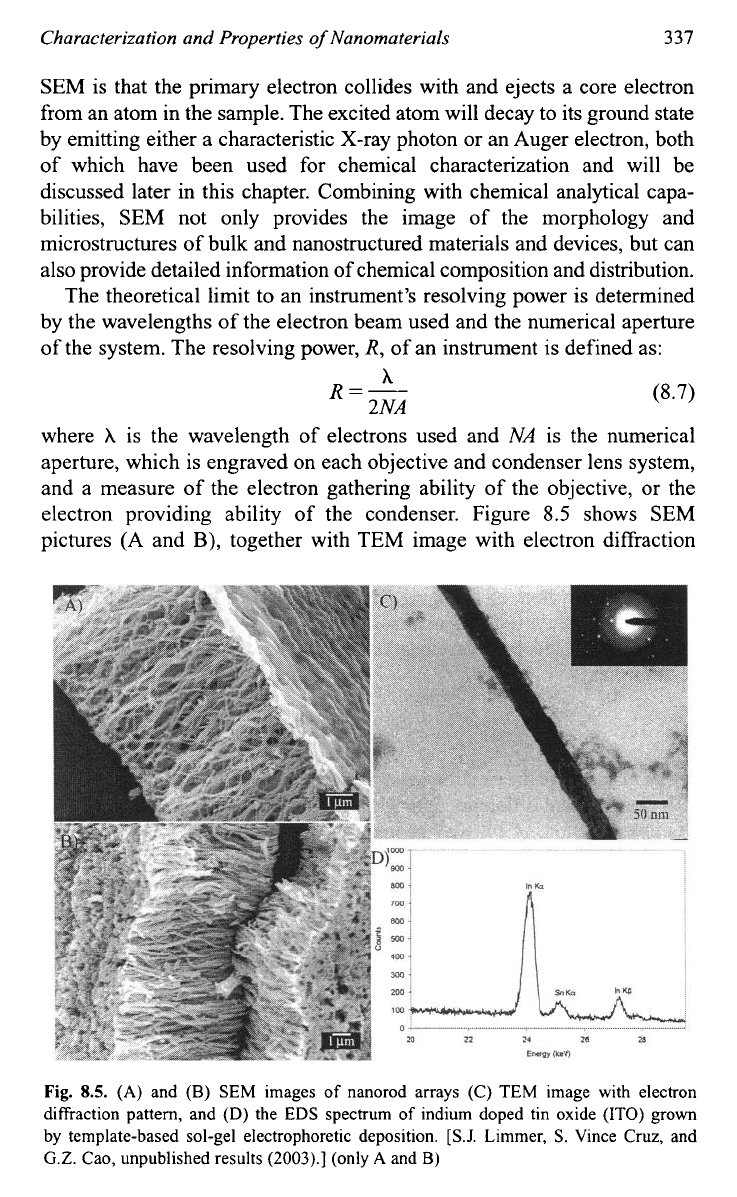
Characterization and Properties
of
Nanomaterials
337
SEM is that the primary electron collides with and ejects a core electron
from an atom in the sample. The excited atom will decay to its ground state
by emitting either a characteristic X-ray photon or an Auger electron, both
of which have been used for chemical characterization and will be
discussed later in this chapter. Combining with chemical analytical capa-
bilities, SEM not only provides the image of the morphology and
microstructures of bulk and nanostructured materials and devices, but can
also provide detailed information of chemical composition and distribution.
The theoretical limit to an instrument’s resolving power is determined
by the wavelengths of the electron beam used and the numerical aperture
of the system. The resolving power,
R,
of an instrument is defined as:
A
R=-
2NA
where
A
is the wavelength of electrons used and
NA
is the numerical
aperture, which is engraved on each objective and condenser lens system,
and a measure of the electron gathering ability of the objective, or the
electron providing ability of the condenser. Figure
8.5
shows SEM
pictures (A and
B),
together with TEM image with electron diffraction
Fig.
8.5.
(A)
and
(B)
SEM images
of
nanorod arrays (C) TEM image with electron
diffraction pattern, and (D) the EDS spectrum
of
indium doped tin oxide
(ITO)
grown
by
template-based sol-gel electrophoretic deposition.
[S.J.
Limmer,
S.
Vince Cruz, and
G.Z.
Cao, unpublished results
(2003).]
(only
A
and
B)
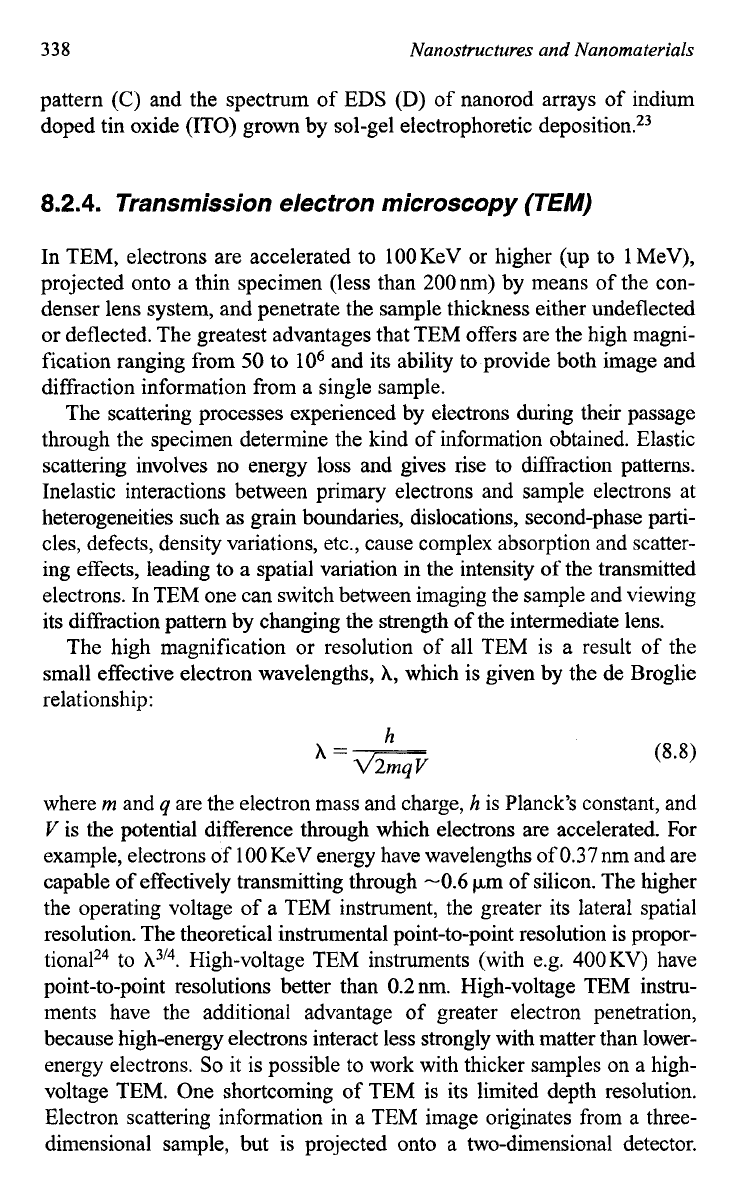
338
Nanostructures and Nanomaterials
pattern
(C)
and the spectrum of EDS (D) of nanorod arrays of indium
doped tin oxide (ITO) grown by sol-gel electrophoretic depo~ition.~~
8.2.4.
Transmission electron microscopy
(TEM)
In TEM, electrons are accelerated to
100
KeV or higher (up to
1
MeV),
projected onto a thin specimen (less than 200nm) by means of the con-
denser lens system, and penetrate the sample thickness either undeflected
or deflected. The greatest advantages that TEM offers are the high magni-
fication ranging from
50
to
lo6
and its ability to provide both image and
diffraction information from a single sample.
The scattering processes experienced by electrons during their passage
through the specimen determine the kind of information obtained. Elastic
scattering involves no energy loss and gives rise to diffraction patterns.
Inelastic interactions between primary electrons and sample electrons at
heterogeneities such as grain boundaries, dislocations, second-phase parti-
cles, defects, density variations, etc., cause complex absorption and scatter-
ing effects, leading to a spatial variation in the intensity of the transmitted
electrons. In TEM one can switch between imaging the sample and viewing
its diffraction pattern by changing the strength
of
the intermediate lens.
The high magnification or resolution of all TEM is a result of the
small effective electron wavelengths,
A,
which
is
given by the de Broglie
relationship:
h
"SV
where
m
and
q
are the electron mass and charge,
h
is Planck's constant, and
V
is the potential difference through which electrons are accelerated. For
example, electrons of
100
KeV energy have wavelengths of
0.37
nm and are
capable
of
effectively transmitting through
-0.6
pm of silicon. The higher
the operating voltage of a TEM instrument, the greater its lateral spatial
resolution. The theoretical instrumental point-to-point resolution is propor-
tionalZ4
to
X3I4.
High-voltage TEM instruments (with e.g. 400KV) have
point-to-point resolutions better than
0.2
nm. High-voltage TEM instru-
ments have the additional advantage of greater electron penetration,
because high-energy electrons interact less strongly with matter than lower-
energy electrons.
So
it is possible to work with thicker samples on a high-
voltage TEM. One shortcoming of TEM is its limited depth resolution.
Electron scattering information in a TEM image originates from a three-
dimensional sample, but is projected onto a two-dimensional detector.
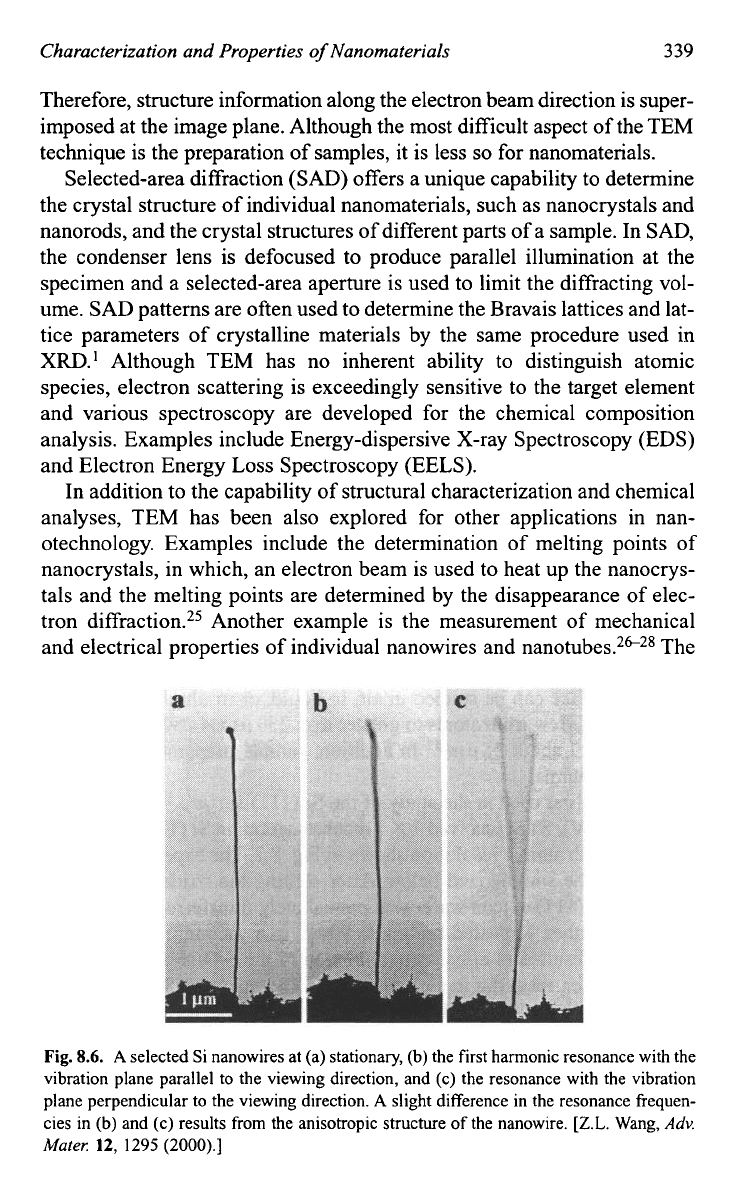
Characterization and Properties
of
Nanomaterials
339
Therefore, structure information along the electron beam direction is super-
imposed at the image plane. Although the most difficult aspect of the TEM
technique is the preparation of samples, it is less
so
for nanomaterials.
Selected-area diffraction (SAD) offers a unique capability to determine
the crystal structure of individual nanomaterials, such as nanocrystals and
nanorods, and the crystal structures
of
different parts
of
a sample. In SAD,
the condenser lens is defocused to produce parallel illumination at the
specimen and a selected-area aperture is used to limit the diffracting vol-
ume. SAD patterns are often used to determine the Bravais lattices and lat-
tice parameters
of
crystalline materials by the same procedure used in
XRD.' Although TEM has no inherent ability to distinguish atomic
species, electron scattering is exceedingly sensitive to the target element
and various spectroscopy are developed for the chemical composition
analysis. Examples include Energy-dispersive X-ray Spectroscopy (EDS)
and Electron Energy
Loss
Spectroscopy (EELS).
In addition to the capability of structural characterization and chemical
analyses, TEM has been also explored for other applications in nan-
otechnology. Examples include the determination of melting points of
nanocrystals, in which, an electron beam is used to heat up the nanocrys-
tals and the melting points are determined by the disappearance of elec-
tron diffra~tion.~~ Another example is the measurement of mechanical
and electrical properties of individual nanowires and nanotubes.2c28 The
Fig.
8.6.
A
selected Si nanowires at (a) stationary, (b) the first harmonic resonance with the
vibration plane parallel to the viewing direction, and (c) the resonance with the vibration
plane perpendicular to the viewing direction.
A
slight difference in the resonance fiequen-
cies in
(b)
and (c) results from the anisotropic structure of the nanowire.
[Z.L.
Wang,
Adv.
Mate,:
12,
1295 (2000).]

340
Nanostructures and Nanomaterials
technique allows a one-to-one correlation between the structure and prop-
erties of the nanowires. Figure
8.6
shows TEM micrographs of a silicon
nanowire when stationary and vibrating at resonance from
which the Young's modulus of this silicon nanowire is determined.
8.2.5.
Scanning probe microscopy
(SPM)
SPM is unique among imaging techniques in that it provides three-dimen-
sional
(3-D)
real-space images and among other analysis techniques in
that it allows spatially localized measurements of structure and properties.
Under optimum conditions subatomic spatial resolution is achieved. SPM
is a general term for a family of microscopes depending on the probing
forces used. Two major members are STM and AFM. The principles of
electron tunneling and atomic forces have been already discussed in
Chapter
7.
For more details, the readers are recommended to an excellent
book7 and references therein.
STM was first developed by Binnig and his coworkers in
1981Z9
and
AFM was invented a few years later.30 The limitation of STM, which is
restricted to electrically conductive sample surface, is complemented by
AFM, which does not require conductive sample surface. Therefore,
almost any solid surface can be studied with SPM: insulators, semicon-
ductors and conductors, magnetic, transparent and opaque materials. In
addition, surface can be studied in air, in liquid, or in ultrahigh vacuum,
with fields of view from atoms to greater than 250 pm
X
250pm, and ver-
tical ranges of about 15
~1.m.~'
In addition, sample preparation for SPM
analysis is minimal.
STM was first used in the study of the Si
(1
1
1)
surface.32 In ultrahigh
vacuum
(UHV),
STM resolved
7
X
7
reconstruction on Si
(1
1
1) surface in
real space with atomic resolution shown in Fig.
8.7.
The experimental pro-
cedures can be summarized below. After etching the oxide with an HF
solution, the
(1 1 1)
silicon wafer was immediately transferred to the STM
in
UHV
chamber. Repeated heating to
900°C
in a vacuum not exceeding
3
X
1
O-*
Pa resulted in effective sublimation of the SiO layer grown dur-
ing the transfer, resulting in a clean surface. The micrographs were taken
at
2.9
V
with tip positive. Only unidirectional scans were recorded to avoid
nonlinear effects of the scanning piezoelectric drives.
As summarized by Lang
et
uZ.~~
in their excellent tutorial article, SPM
has been developed to a wide spectrum of techniques using various probe
and sample surface interactions, as shown in Fig.
8.8.
The interaction
force may be the interatomic forces between the atoms of the tip and those
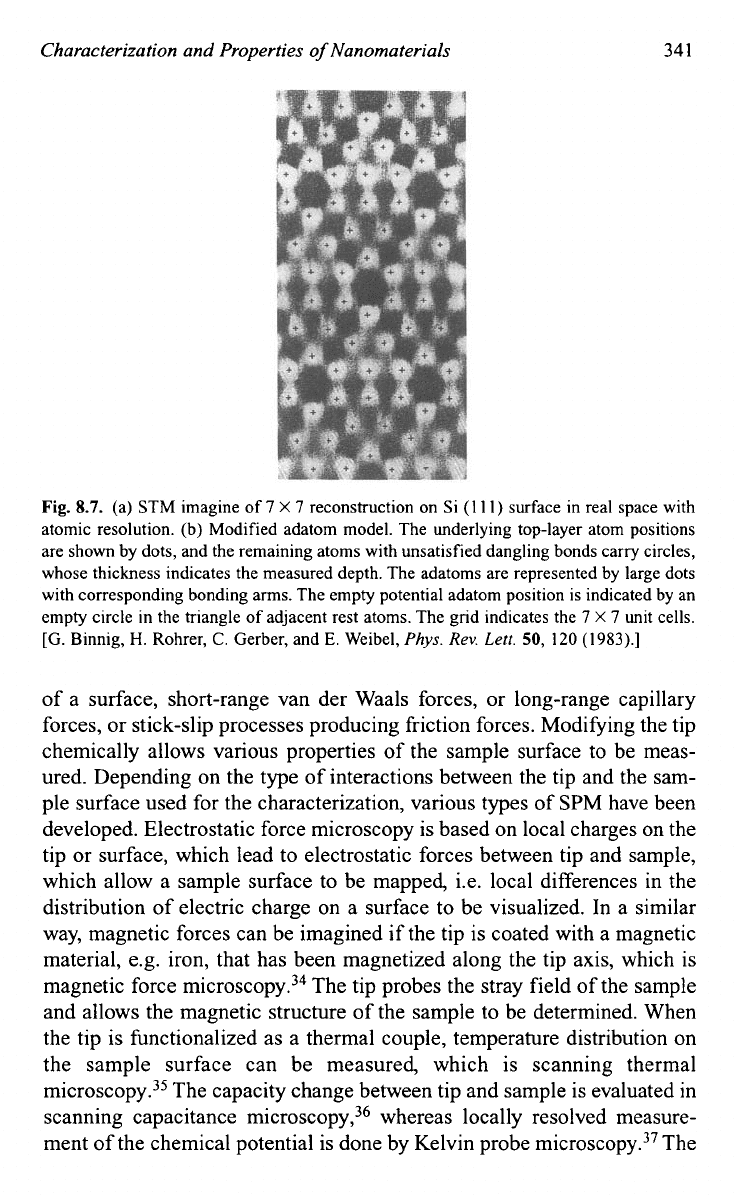
Characterization and Properties
of
Nanomaterials
34
1
Fig.
8.7.
(a) STM imagine of
7
X
7
reconstruction on Si
(1
1
1)
surface in real space with
atomic resolution. (b) Modified adatom model. The underlying top-layer atom positions
are shown by dots, and the remaining atoms with unsatisfied dangling bonds carry circles,
whose thickness indicates the measured depth. The adatoms are represented by large dots
with corresponding bonding arms. The empty potential adatom position is indicated by an
empty circle in the triangle of adjacent rest atoms. The grid indicates the
7
X
7
unit cells.
[G. Binnig,
H.
Rohrer, C. Gerber, and
E.
Weibel,
Phys.
Rev.
Lett. 50,
120
(1
983).]
of a surface, short-range van der Waals forces, or long-range capillary
forces, or stick-slip processes producing friction forces. Modifying the tip
chemically allows various properties of the sample surface to be meas-
ured. Depending on the type of interactions between the tip and the sam-
ple surface used for the characterization, various types of SPM have been
developed. Electrostatic force microscopy is based on local charges on the
tip or surface, which lead to electrostatic forces between tip and sample,
which allow a sample surface to be mapped, i.e. local differences in the
distribution of electric charge on a surface to be visualized. In a similar
way, magnetic forces can be imagined if the tip is coated with a magnetic
material, e.g. iron, that has been magnetized along the tip axis, which is
magnetic force micro~copy.~~ The tip probes the stray field of the sample
and allows the magnetic structure of the sample
to
be determined. When
the tip is functionalized as a thermal couple, temperature distribution on
the sample surface can be measured, which is scanning thermal
micro~copy.~~ The capacity change between tip and sample is evaluated in
scanning capacitance micro~copy,~~ whereas locally resolved measure-
ment of the chemical potential is done by Kelvin probe micro~copy.~~ The
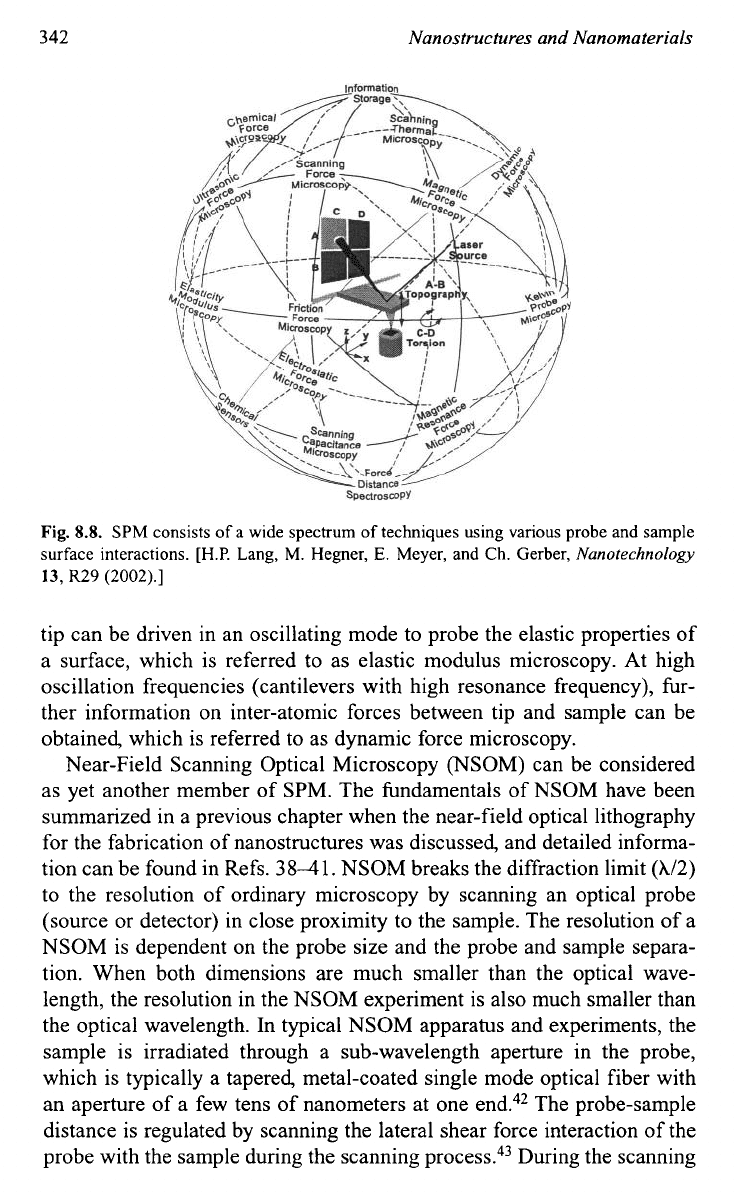
342
Nanostructures and Nanomaterials
Fig.
8.8.
SPM
consists
of
a wide spectrum
of
techniques using various probe and sample
surface interactions.
[H.P.
Lang,
M.
Hegner,
E.
Meyer, and
Ch.
Gerber,
Nanotechnology
13,
R29
(2002).]
tip can be driven in an oscillating mode to probe the elastic properties of
a surface, which is referred to as elastic modulus microscopy. At high
oscillation frequencies (cantilevers with high resonance frequency), fur-
ther information on inter-atomic forces between tip and sample can be
obtained, which is referred to as dynamic force microscopy.
Near-Field Scanning Optical Microscopy (NSOM) can be considered
as yet another member of SPM. The fundamentals of NSOM have been
summarized in a previous chapter when the near-field optical lithography
for the fabrication of nanostructures was discussed, and detailed informa-
tion can be found in Refs.
38-41.
NSOM breaks the diffraction limit
(U2)
to
the resolution of ordinary microscopy by scanning an optical probe
(source or detector) in close proximity to the sample. The resolution of a
NSOM
is
dependent
on
the probe size and the probe and sample separa-
tion. When both dimensions are much smaller than the optical wave-
length, the resolution in the NSOM experiment is also much smaller than
the optical wavelength. In typical NSOM apparatus and experiments, the
sample is irradiated through a sub-wavelength aperture in the probe,
which is typically a tapered, metal-coated single mode optical fiber with
an aperture of a few tens of nanometers at one end.42 The probe-sample
distance is regulated by scanning the lateral shear force interaction of the
probe with the sample during the scanning process.43 During the scanning
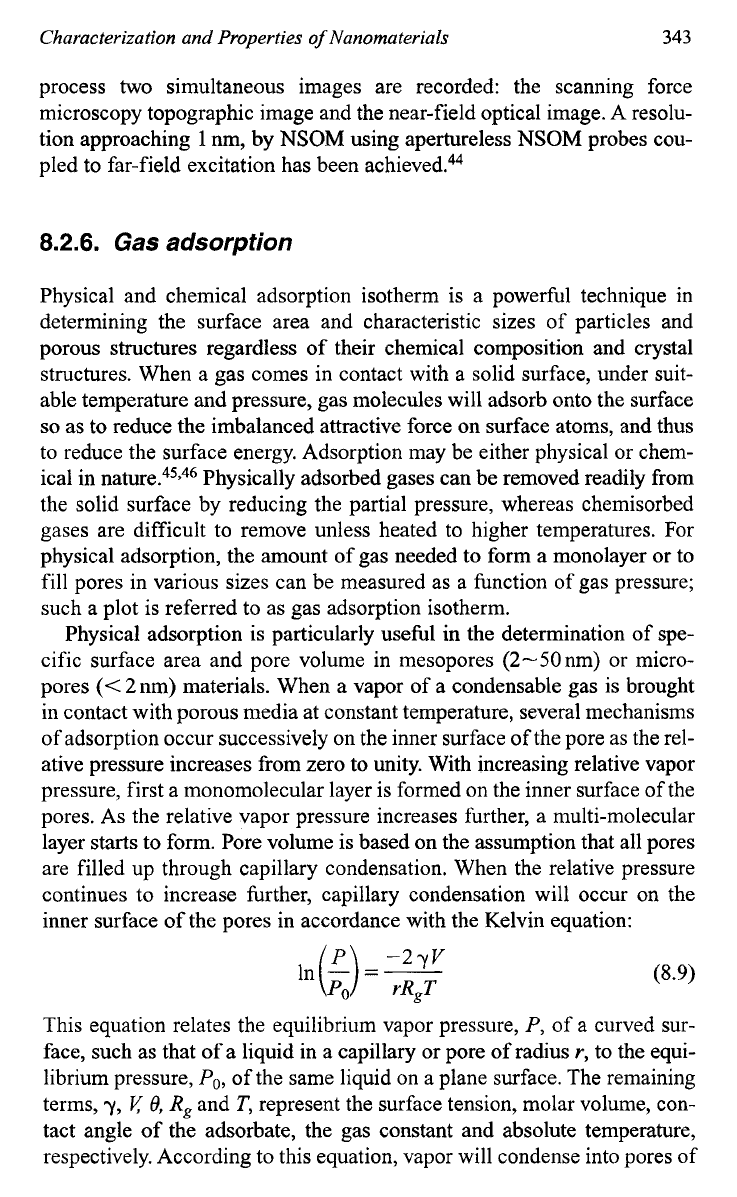
Characterization and Properties
of
Nanomaterials
343
process
two
simultaneous images are recorded: the scanning force
microscopy topographic image and the near-field optical image.
A
resolu-
tion approaching
1
nm, by
NSOM
using apertureless
NSOM
probes cou-
pled to far-field excitation has been achieved.44
8.2.6.
Gas
adsorption
Physical and chemical adsorption isotherm is a powerful technique in
determining the surface area and characteristic sizes of particles and
porous structures regardless of their chemical composition and crystal
structures. When a gas comes in contact with a solid surface, under suit-
able temperature and pressure, gas molecules will adsorb onto the surface
so
as to reduce the imbalanced attractive force on surface atoms, and thus
to reduce the surface energy. Adsorption may be either physical or chem-
ical in nat~re.~~.~~ Physically adsorbed gases can be removed readily from
the solid surface by reducing the partial pressure, whereas chemisorbed
gases are difficult to remove unless heated to higher temperatures. For
physical adsorption, the amount of gas needed to form a monolayer or to
fill pores in various sizes can be measured as a function of gas pressure;
such a plot
is
referred to as gas adsorption isotherm.
Physical adsorption is particularly useful in the determination of spe-
cific surface area and pore volume in mesopores (2-5Onm) or micro-
pores
(<
2
nm) materials. When a vapor
of
a condensable gas is brought
in contact with porous media at constant temperature, several mechanisms
of adsorption occur successively on the inner surface of the pore as the rel-
ative pressure increases from zero to unity. With increasing relative vapor
pressure, first a monomolecular layer
is
formed on the inner surface of the
pores. As the relative vapor pressure increases further, a multi-molecular
layer starts to form. Pore volume is based on the assumption that all pores
are filled up through capillary condensation. When the relative pressure
continues to increase further, capillary condensation will occur on the
inner surface of the pores in accordance with the Kelvin equation:
This equation relates the equilibrium vapor pressure,
P,
of a curved sur-
face, such as that of a liquid in a capillary or pore of radius
r,
to the equi-
librium pressure,
Po,
of the same liquid on a plane surface. The remaining
terms,
y,
K
0,
Rg
and
T,
represent the surface tension, molar volume, con-
tact angle of the adsorbate, the gas constant and absolute temperature,
respectively. According to this equation, vapor will condense into pores of
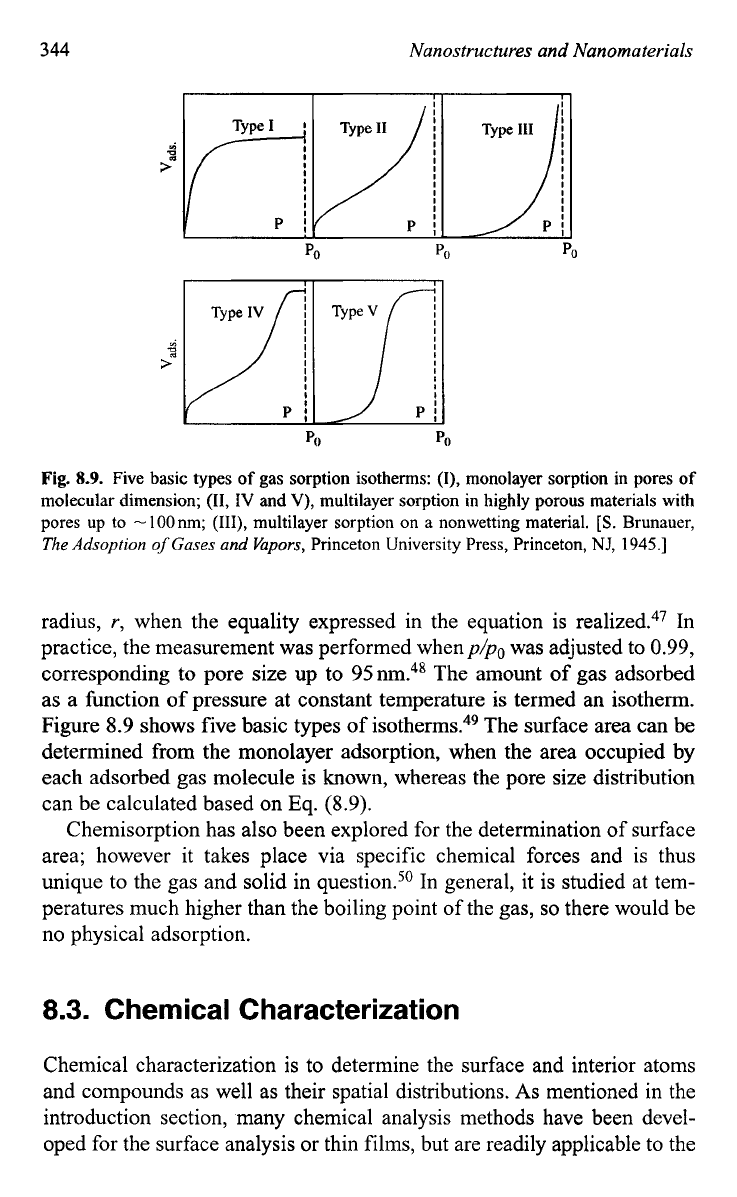
344
Nanostructures and Nanomaterials
I
1
Po
Po
Fig.
8.9.
Five basic types
of
gas sorption isotherms:
(I),
monolayer sorption in pores
of
molecular dimension;
(11,
IV
and
V),
multilayer sorption in highly porous materials with
pores up to -100nm;
(111),
multilayer sorption on a nonwetting material. [S. Brunauer,
The
Adsoption
of
Gases
and
Vapors,
Princeton University Press, Princeton,
NJ,
1945.1
radius,
r,
when the equality expressed in the equation is realized.47 In
practice, the measurement was performed whenp/Po was adjusted to
0.99,
corresponding to pore size up to 95nm.48 The amount
of
gas adsorbed
as a function
of
pressure at constant temperature
is
termed an isotherm.
Figure
8.9
shows five basic types
of
isotherms.49 The surface area can be
determined from the monolayer adsorption, when the area occupied by
each adsorbed gas molecule
is
known, whereas the pore size distribution
can be calculated based on
Eq.
(8.9).
Chemisorption has also been explored for the determination of surface
area; however it takes place via specific chemical forces and is thus
unique to the gas and solid in question.50 In general, it is studied at tem-
peratures much higher than the boiling point of the gas,
so
there would be
no physical adsorption.
8.3.
Chemical Characterization
Chemical characterization
is
to determine the surface and interior atoms
and compounds as well as their spatial distributions.
As
mentioned in the
introduction section, many chemical analysis methods have been devel-
oped for the surface analysis or thin films, but are readily applicable to the
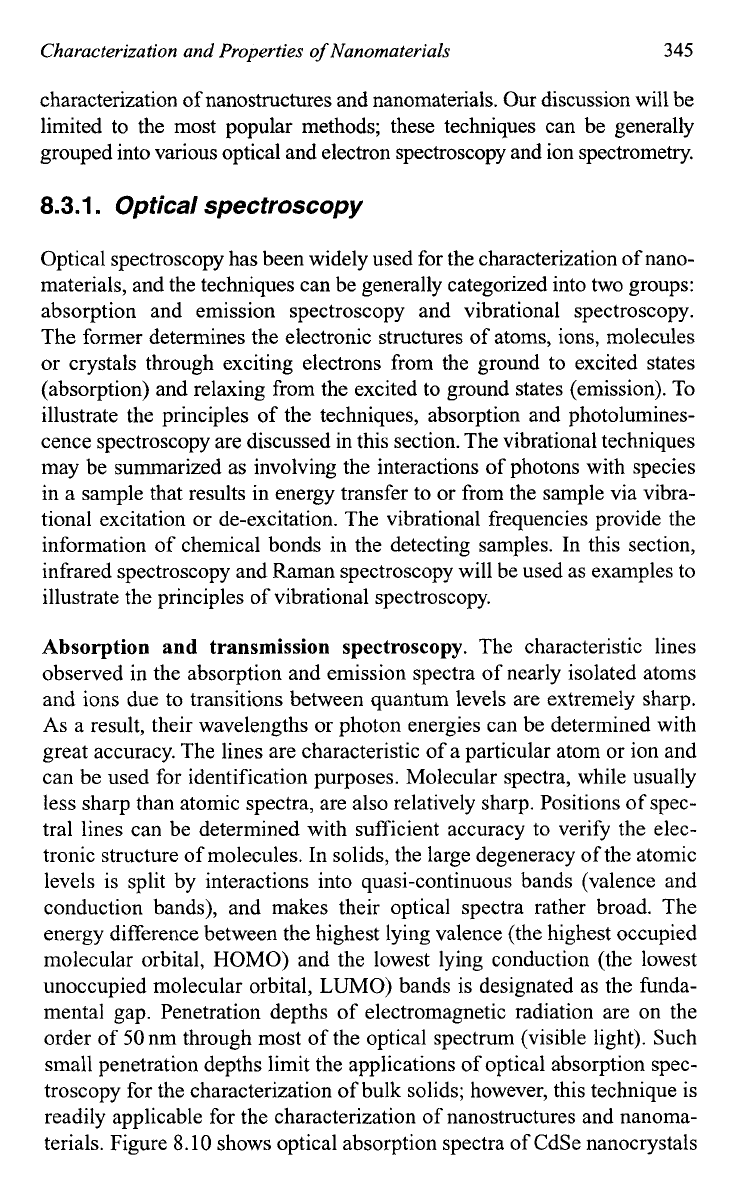
Characterization and Properties
of
Nanomaterials
345
characterization of nanostructures and nanomaterials. Our discussion will be
limited to the most popular methods; these techniques can be generally
grouped into various optical and electron spectroscopy and ion spectrometry.
8.3.1.
Optical spectroscopy
Optical spectroscopy has been widely used for the characterization of nano-
materials, and the techniques can be generally categorized into two groups:
absorption and emission spectroscopy and vibrational spectroscopy.
The former determines the electronic structures of atoms, ions, molecules
or crystals through exciting electrons from the ground to excited states
(absorption) and relaxing from the excited to ground states (emission). To
illustrate the principles of the techniques, absorption and photolumines-
cence spectroscopy are discussed in this section. The vibrational techniques
may be summarized as involving the interactions of photons with species
in a sample that results in energy transfer to or from the sample via vibra-
tional excitation or de-excitation. The vibrational frequencies provide the
information of chemical bonds in the detecting samples. In this section,
infrared spectroscopy and Raman spectroscopy will be used as examples to
illustrate the principles
of
vibrational spectroscopy.
Absorption and transmission spectroscopy.
The characteristic lines
observed in the absorption and emission spectra of nearly isolated atoms
and ions due to transitions between quantum levels are extremely sharp.
As
a result, their wavelengths or photon energies can be determined with
great accuracy. The lines are characteristic of a particular atom or ion and
can be used for identification purposes. Molecular spectra, while usually
less sharp than atomic spectra, are also relatively sharp. Positions of spec-
tral lines can be determined with sufficient accuracy to verify the elec-
tronic structure of molecules. In solids, the large degeneracy of the atomic
levels is split by interactions into quasi-continuous bands (valence and
conduction bands), and makes their optical spectra rather broad. The
energy difference between the highest lying valence (the highest occupied
molecular orbital, HOMO) and the lowest lying conduction (the lowest
unoccupied molecular orbital,
LUMO)
bands is designated as the funda-
mental gap. Penetration depths of electromagnetic radiation are on the
order of
50
nm through most of the optical spectrum (visible light). Such
small penetration depths limit the applications of optical absorption spec-
troscopy for the characterization
of
bulk solids; however, this technique is
readily applicable for the characterization of nanostructures and nanoma-
terials. Figure
8.10
shows optical absorption spectra of CdSe nanocrystals
